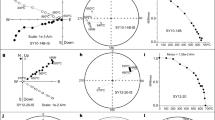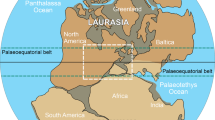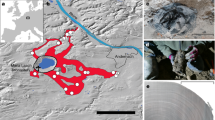Abstract
Several possible configurations of the Pangaea supercontinent have been suggested for the interval from late Carboniferous to early Triassic. Here we re-examine the palaeomagnetic basis for these models, emphasizing the trends of the paths of apparent polar wander for the individual components of the supercontinent rather than simply averaging poles of presumed similar age. Two of the alternatives, Pangaea B and C, may result from averaging poles of dissimilar age along common polar wander paths, giving rise to spurious tectonic displacements. The most likely model appears to be the formation, in late Devonian time, of a modified Pangaea (A2) followed by evolution to the traditional configuration (A) during the Triassic.
This is a preview of subscription content, access via your institution
Access options
Subscribe to this journal
Receive 51 print issues and online access
$199.00 per year
only $3.90 per issue
Buy this article
- Purchase on Springer Link
- Instant access to full article PDF
Prices may be subject to local taxes which are calculated during checkout
Similar content being viewed by others
References
Hallam, A. Nature 301, 499–502 (1983).
Van der Voo, R. & French, R. B. Earth Sci. Rev. 10, 99–119 (1974).
Van der Voo, R. et al. Geology 4, 177–180 (1976).
Scotese, C. R., Bambach, R. K., Barton, C., Vander Voo, R. & Ziegler, A. M. J. Geol. 87, 217–277 (1979).
Walper, J. L. in The origin of the Gulf of Mexico and the Early Opening of the Central North Atlantic Ocean (ed. Pilger, R. H.) 87–98 (Louisiana State University, Baton Rouge, 1980).
Vine, F. J. Palaeontol. Ass. spec. Pap. 12, 61–77 (1973).
Irving, E. Nature 270, 304–309 (1977).
Westphal, M. Nature 267, 136–137 (1977).
Kanasewich, E. R., Havskov, J. & Evans, M. E. Can. J. Earth Sci. 15, 919–955 (1978).
Morel, P. & Irving, E. J. geophys. Res. 86, 1858–1872 (1981).
Irving, E. Geophys. Surv. 5, 299–333 (1983).
Smith, A. G., Hurley, A. M. & Briden, J. C. Phanerozoic Palaeocontinental Maps (Cambridge University Press, 1981).
Livermore, R. A. thesis, Univ. East Anglia, Norwich (1985).
Embleton, B. J. J. in Palaeoreconstruction of the Continents (eds McElhinny, M. W. & Valencio, D. A.) 77–92 (American Geophysical Union, Washington, 1981).
Van der Voo, R. in Palaeoreconstruction of the Continents (eds McElhinny, M. W. & Valencio, D. A.) 159–176 (American Geophysical Union, Washington, 1981).
Brock, A. in Palaeoreconstruction of the Continents (eds McElhinny, M. W. & Valencio, D. A.) 65–76 (American Geophysical Union, Washington, 1981).
McElhinny, M. W. Palaeomagnetism and Plate Tectonics (Cambridge University Press, 1973).
Harland, W. B. et al. A Geologic Timescale (Cambridge University Press, 1982).
Steiger, R. H. & Jaeger, E. Earth planet. Sci. Lett. 36, 359–362 (1977).
Kent, D. V., Dia, O. & Sougy, J. M. A. in Plate Reconstruction from Palaeozoic Palaeomagnetism (eds Van der Voo, R., Scotese, C. R. & Bonhommet, N.) 99–115 (American Geophysical Union, Washington, 1984).
Livermore, R. A., Smith, A. G. & Briden, J. C. Phil. Trans. R. Soc. B 309, 29–56 (1985).
Scotese, C. R. in Plate Reconstruction from Palaeozoic Palaeomagnetism (eds Van der Voo, R., Scotese, C. R. & Bonhommet, N.) 1–10 (American Geophysical Union, Washington, 1984).
Pamic;, J. J. Ann. Soc. geol. Nord. C III, 133–141 (1983).
Pamic, J. J. Tectonophysics 109, 273–307 (1984).
Sheridan, R. E. et al. geol. Soc. Am. Bull. 93, 876–886 (1982).
Le Fort, J.-P. Mar. Geol. 37, 355–369 (1980).
Klitgord, K. D. & Schouten, H. Eos 63, 307 (1982).
Rabinowitz, P. D. & LaBrecque, J. J geophys. Res. 84, 5973–6002 (1979).
Norton, I. O. & Sclater, J. G. J. geophys. Res. 84, 6803–6830 (1979).
Segoufin, J. & Patriat, P. Bull Soc. géol. Fr. 23, 603–607 (1981).
Smith, A. G. & Hallam, A. Nature 225, 139–144 (1970).
Wegener, A. The Origin of the Continents and Oceans (Methuen, London, 1924).
Bullard, E. C., Everett, J. E. & Smith, A. G. Phil. Trans. R. Soc. A 258, 41–51 (1965).
Author information
Authors and Affiliations
Rights and permissions
About this article
Cite this article
Livermore, R., Smith, A. & Vine, F. Late Palaeozoic to early Mesozoic evolution of Pangaea. Nature 322, 162–165 (1986). https://doi.org/10.1038/322162a0
Received:
Accepted:
Issue Date:
DOI: https://doi.org/10.1038/322162a0
This article is cited by
-
Permian-Triassic of the Tethys: Carbon isotope studies
Geologische Rundschau (1989)
Comments
By submitting a comment you agree to abide by our Terms and Community Guidelines. If you find something abusive or that does not comply with our terms or guidelines please flag it as inappropriate.



